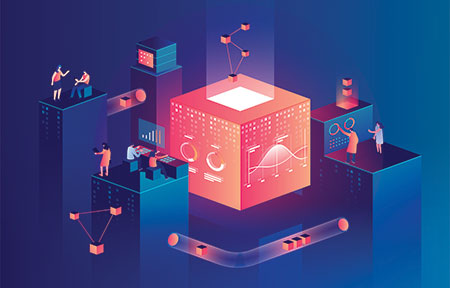By Andrea Wilkerson
 The mention of intelligent, connected lighting systems may immediately start a swirling of ideas around the limitless possibilities, but in these still-early days, it may be more likely to render a headache. While the ability of lighting systems to share data with other systems is exciting, the implementation can quickly become overwhelming. The struggle to understand, manage and effectively utilize data is real and not going away anytime soon.
The mention of intelligent, connected lighting systems may immediately start a swirling of ideas around the limitless possibilities, but in these still-early days, it may be more likely to render a headache. While the ability of lighting systems to share data with other systems is exciting, the implementation can quickly become overwhelming. The struggle to understand, manage and effectively utilize data is real and not going away anytime soon.
The changing pace of the lighting industry continues. We are learning new terminology, working with different disciplines, acquiring (or perhaps just desiring) new skill sets and pondering what’s next, while still trying to meet the demands each day brings. While those nearing retirement may be able to avoid pythons, rhinos and honeybees, many in lighting are wishing for another programming or data science class, or degree.
A recent article by Steven Burrows in Structure Magazine, “Disruption is Coming to the Building Industry,” paints an exciting picture for the future of buildings, targeting a 50% increase in the productivity of the building industry. This increase in productivity is coming, he argues, because technology has already disrupted all other traditional high-cost, low-productivity industries, leaving the building industry as the last major industry for technology to disrupt. How will lighting fit into this future?
It may be difficult to imagine this future if you have been part of installing and commissioning an advanced commercial lighting system recently, particularly if you had the expectation that it would be easier because lighting systems are getting smarter and more interoperable. Such lighting systems have always presented great promise for benefits to occupants, along with energy savings, but too often disappointment follows. What can be done today with the data that is available from lighting systems to avoid disappointment, add value and meet client expectations?
Data detailing the state of the lighting system is increasingly available, either directly from the lighting system or fed from the lighting system to the building automation system. While today it may still take some work to analyze and understand this data, hopefully in the future the data becomes easier to access and use productively. Insights into the state of the lighting system throughout the day are particularly valuable for more sophisticated systems (e.g., those that can vary the spectrum) serving a variety of space types. This data is useful for refinement during system commissioning, providing the specifier and other stakeholders the opportunity to make sure the lighting system is operating as intended. Flexibility with sophisticated systems is often touted as a benefit, and having the data to show what changes will improve the system performance takes advantage of this flexibility.
This data is also valuable feedback for manufacturers, as it is impossible for them to test every configuration of their system, especially when their system needs to work with multiple other manufacturers in a time of continuous technology changes. Additionally, the definitions of what “interoperable” means vary across the industry and are still being refined by various stakeholder groups. Even the order in which user interface buttons are pressed can change the response of the system, which makes it even more difficult to understand all the possibilities before these systems are installed.
As systems continue to increase in complexity, the need for data to simplify the task of verifying the operation of the system will only increase in importance. This is readily apparent for color-tunable lighting systems, where intensity and spectrum may be changing throughout the day. The spectrum and intensity of every luminaire needs to be verified for every scene, along with considerations of timeclocks and their interactions with the user control interfaces. This is a considerable increase in the number of variables that need to be verified, compared to the days of large zones of static white luminaires, with a couple of switches to flip on and off.
Real data on how a sophisticated lighting system is used can help the lighting specifier design a better system in the future, as they too are learning about how to best implement new lighting system features and control strategies. Understanding how occupants interact with the lighting system provides valuable feedback for continual improvement. It can also help facilities staff and building owners understand whether it is worth investing in additional features. There is no shortage of advertising dedicated to new features, but what is often left out of discussions is data showing that the new features are actually useful to occupants.
At the IES Annual Conference in Louisville, larger data sets were a part of many conversations and presentations, from the TM-30 experience room, to IoT and cybersecurity. In one of the presentations, Katy Boat of SmithGroup, Michael Myer of Pacific Northwest National Laboratory and Kevin Powell of the General Services Administration (GSA) looked carefully at an installation of an intelligent lighting system in a GSA building. The new system allows the facilities manager to see how the space is being used throughout the week in a hoteling environment, where there are more employees assigned to a floor than there are desks. While some of the findings—such as that less people are in the office on Fridays—may not be a surprise, other findings—such as the areas of the floor that are used the most at various times of day, and the patterns of movement throughout the space—are more nuanced.
This type of data is helpful to managers who are trying to understand how to better design their spaces so that they are utilized more effectively—or, as was mentioned during the presentation, perhaps on Fridays the maintenance staff can skip a floor or two and attend to other tasks. On large campuses, there may be many requests for additional space from different teams, and understanding this occupancy data is helpful for prioritizing requests and determining additional space size and type needs—from conference rooms to phone booths. This data is also valuable feedback for the entire design team and is much more robust than a survey that is only one point in time and taken by only a subset of the building occupants.
We are all learning together as the lighting industry shifts to more sophisticated lighting systems. The U.S. Department of Energy (DOE) Solid-State Lighting (SSL) program continues to focus on addressing configuration complexity and better understanding the value of data to various lighting and non-lighting stakeholders. Continuing to address the promises of SSL along with today’s performance challenges will be a focus at the 17th annual DOE Lighting R&D Workshop, which will be held in San Diego January 28-30, 2020, to help bridge the gap between technology promise and today’s reality. Co-sponsored by IES, the workshop will feature deep-dive R&D discussions and expanded track sessions exploring topics related to emerging lighting science, connected lighting advances, building integration challenges and more. Mark your calendars and plan to join us.

